Australia’s attitudes and perceptions towards drugs by region
Overview
Analysis on the National Drug Strategy Household Survey from 2019 found that about 3 in 4 Australians aged 14 and over had consumed alcohol in the previous 12 months, over 1 in 10 had smoked tobacco daily, and 2 in 5 had used an illicit drug in their lifetime (AIHW 2020).
Understanding what Australians think about drug use and their level of support for government drug policies is important for policy planning, development and evaluation.
The National Drug Strategy Household Survey (NDSHS) is an important national survey that collects self-reported information from people across Australia. It asks people what they think about tobacco, alcohol and other drugs and about their use of these drugs. It also asks people about the measures that Australia takes to reduce drug use and drug-related harm. These include government laws for the sale and advertising of tobacco and alcohol, taxes on tobacco products, and government funding of rehabilitation and withdrawal management treatment programs. The survey captures important data on emerging issues such as support for pill testing/drug checking services, and emerging policy issues including electronic cigarettes/vaping and medicinal use of cannabis.
This report presents new analysis from the 2019 NDSHS that focuses on the attitudes and perceptions of people across Australia on various drug-related issues. All results are for people aged 14 and over and are based on self-reported data. The interactive data map allows people to select the region to see what people in that region thought about tobacco smoking, alcohol use, cannabis and other illicit drugs in 2019. The 2022 survey is currently in the field and will be completed in early December 2022. Households are randomly selected to complete the survey and have their say.
Measures to reduce tobacco use
In 2019, most people supported government policies to reduce tobacco use and support was highest for measures related to protecting young people and minors. Measures to increase tax on tobacco products had the highest level of opposition. Support for tobacco policies was high across most regions. Explore the interactive data map for results by region.
Figure 1: Level of support and opposition for measures to reduce the problems associated with tobacco, people aged 14 and over, 2019
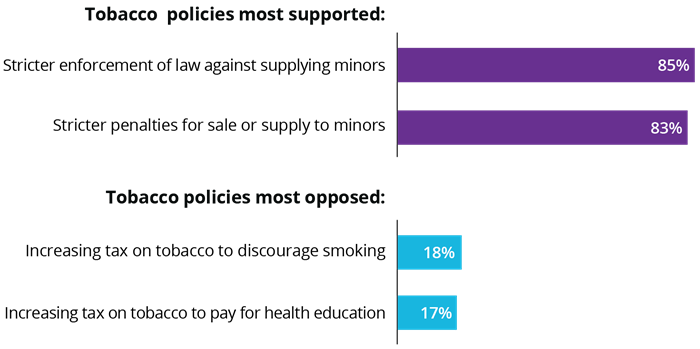
About 7 in 10 (69%) people thought the use of electronic cigarettes should be restricted in public places and have similar restrictions to traditional cigarettes. However, the level of support varies by region and by jurisdiction, with 72% of people in the ACT supporting this measure compared with 61% in the Northern Territory. Explore the interactive data map for results by region.
Measures to reduce excessive alcohol use
To reduce problems associated with excessive use of alcohol, people most supported measures related to existing alcohol-related laws such as more severe legal penalties for drink-driving. Measures that would make it more difficult or more costly to obtain alcohol received the most opposition. Different policies however, had varying levels of support across jurisdictions and regions. For example, people living in Northern Territory were more likely to support ‘reducing the number of outlets that sell alcohol’ in comparison to people living in South Australia (33% supported it compared with 24%). Explore the interactive data map for more information.
Figure 2: Level of support and opposition for measures to reduce the problems associated with excessive alcohol use, people aged 14 and over, 2019
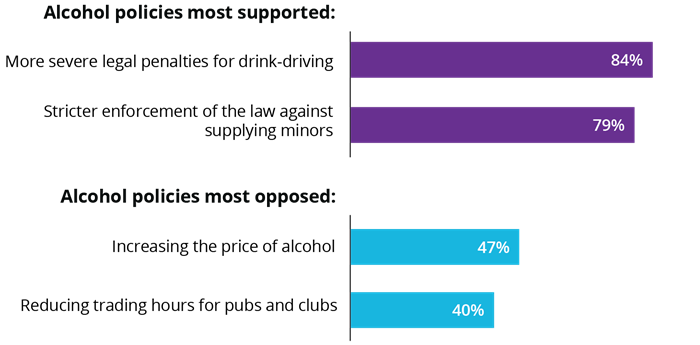
Approval of regular drug use
In 2019, nearly 1 in 2 (45%) people approved of regular use of alcohol by adults. This approval level was higher than for any other drug. Alcohol was also the only drug for which the level of approval was higher than disapproval (45% compared with 21%).
 For the first time in 2019, cannabis had a higher level of personal approval of regular use by an adult than tobacco (20% compared with 15%).
For the first time in 2019, cannabis had a higher level of personal approval of regular use by an adult than tobacco (20% compared with 15%).
Community support for cannabis
Community tolerance for cannabis use has risen. Survey respondents were asked about their support for legalisation, penalties and actions taken against people involved with cannabis. More people supported legalisation of cannabis in 2019 (41%) than in 2010 (25%) and 2019 was the first time more people supported the legalisation of cannabis than opposed it (41% compared with 37%). Fewer people thought that possession of cannabis should be a criminal offence or that penalties should be increased for the sale or supply of cannabis.
Figure 3: Support for measures relating to cannabis use, people aged 14 and over, 2010 and 2019
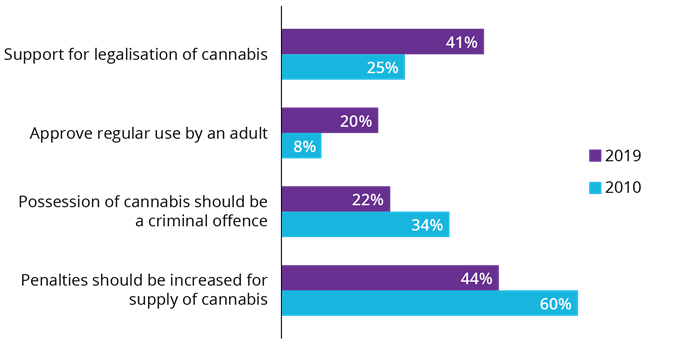
If cannabis were to be legalised, nearly 4 in 5 (78%) people said they would still not use it. Over time, the proportion of people who said they would ‘try it’ has increased from 5.3% in 2010 to 9.5% in 2019. People living in Tasmania were less likely to say they would try cannabis if it were legal than people living in the ACT (7.5% compared with 11%).
Explore the interactive data map to see whether people in other regions showed similar levels of support.
Other illicit drug measures
Support for the legalisation of drugs remained low in 2019 although it has increased since 2010 for some drugs. Support for legalisation of cocaine increased from 6.3% in 2010 to 8.0% in 2019 and for ecstasy increased from 6.8% to 9.5%. Support for the legalisation of heroin (5.6%) and meth/amphetamines (4.6%) has remained similar over the past decade.
Pill testing
Almost 3 in 5 (57%) Australians supported allowing people to test their pills/drugs at designated sites, 1 in 4 (27%) opposed this measure. There was large variation in the level of support for pill testing across Australia—people living in the ACT were the most likely to support it while people living in the Northern Territory were the least likely to support it (70% compared with 54%). Explore the interactive data map to see whether people in other regions mainly support or oppose pill testing.
Actions for people found in possession of drugs for personal use
The most common action supported for people in possession of small quantities of selected drugs for personal use was for ‘referral to treatment or education program’. Cannabis was the only exception, where more than half (54%) of people supported ‘a caution/warning or no action’ compared with 24% for ‘referral to treatment or education program’. However, other people thought possession should result in a prison sentence (20% for meth/amphetamines; 19% for heroin).
Figure 4: Proportion that thought referral to treatment or an education program was the best action if found in possession of selected drugs, people aged 14 and over, 2019
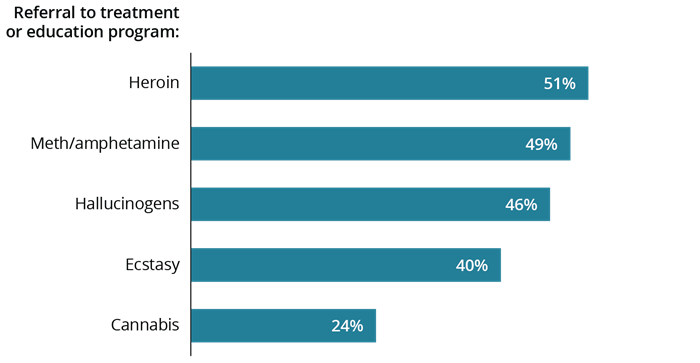
Spending on education, treatment, and law enforcement
People’s priorities were explored by asking how a hypothetical $100 should be split between education, treatment, or law enforcement to reduce the harm of alcohol and illicit drugs.
Education continued to receive the greatest proportion of the allotted $100 for alcohol ($41), and 2019 was the first time people allocated more money to education than law enforcement to reduce illicit drug use. The allotted dollars for law enforcement for alcohol and illicit drugs both fell compared with allocations in 2010.
Figure 5: Distribution of a hypothetical $100 to reduce the use of alcohol or illicit drugs, people aged 14 and over, 2010 and 2019
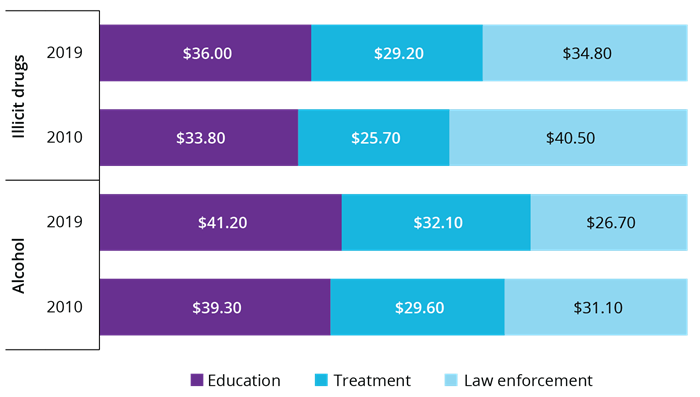
References
AIHW 2020. National Drug Strategy Household Survey 2019. Drug statistics series no. 32. Cat. no. PHE 270. Canberra: AIHW.


